To make the garden bright and elegant, invite Kobei into it. This effectively blooming shrub liana is simply created for vertical landscaping of the household site. The birthplace of the thermal-loving "reel" are mountain forests of American tropics and subtropics. In Russia, it is grown mainly as an annolerary culture, since the local harsh winter Kobhei does not like.
Description of Kobei
The flower is highlighted in long, more than 6 m in height, stems. Common leaves are growing at the next order, and the shooters of shoots are crowned with tenacious mustaches, thanks to which Kobei can break away from the ground with its own forces, whom whatever the foundation. Liana grows very quickly, in the shortest possible time decorating the large vertical surfaces.
Flowers Kobey large (up to 8 cm in diameter) "bells", exacerating a pleasant musky smell: During the growing season, long flowers appear from the sinuses of the leaves, topped with solitary or grouped 2 to 3 pieces with large stamens and pestle. Young buton petals are first painted in greenish-yellow color, later the flower becomes white or purple (it depends on the variety). Kobei fruits are similar to boxes, elastic and leathery to the touch filled with small rounded seeds.
If the sun often pour flower with his light and warmth, Kobe will certainly answer him reciprocity: in good weather it grows surprisingly quickly. At the same time, powerful urine roots of the plant actively consume nutrients from the environment.
In the family of Kobei, there are nine varieties of the flower, on only one species in decorative flower growing. This cobbe is crazy, or, as she is still like to call, "Monastic bells". It is successfully grown as an elegant ornament of the garden.
Planting Kobei.
The path of the development of Kobei from the seed to beautifully blooming Liana can be correlated with two important stages: the first seed seeds on the seedlings are landing for seeding, on the second, germinated seeds are planted into the soil.
The tropical "pedigree" determined the principal trait of this liana: it does not tolerate the minus temperature, therefore cultivated as a uneline. Get such beauty in the garden can be exclusively through the landing of Kobei seeds.
We invite you to familiarize yourself with the step-by-step instructions for the cultivation of this plant:
- early spring starts to work with seeds. The bottom of the wooden tray will be rested by several layers of gauze or dense toilet paper, after which they impregnate the litter with a diluted solution of manganese (potassium permanganate). The seeds of Kobei lay out one thing at a short distance from each other. The tray with a future seedler can be preserved with polyethylene;
- the place for the tray is chosen warm, under the scattered sunshine. It is not scary if the seeds suddenly cover the mucus: then they are washed with a solution of manganese, change the gauze and again lay out the purified planting material. Gentle sprouts appear after 17-20 days. When shoots will grow slightly, they are transplanted into a total capacity;
- the approximate diameter of the total pots for seedlings of the Kobei is 8 - 10 cm. The loose substrate pour into it and break the seedlings to a depth of 1.5 cm. Each seed is placed in a horizontal position, flat side. With the advent of the first leaf on a sapling, it is placed in a separate container, not forgetting to insert a peg in the ground - "I grind" a truck "!
- to disembarking in an open ground (late April - beginning of May), seedlings are prepared in advance. For 15 - 20 days before transplanting, seedlings are ordered, exposing pots for the night of the balcony. It is impossible to do this if freezes still happen at night;
- quickly growled, seedlings are very dramatized, and this significantly reduces its decorative qualities. To form a magnificent branching crown, young lianas pinch;
- for successful acclimatization of the young kobe, choose the solar and the most closed place from the winds: near the fence or the wall at home, for example. With the lack of sunlight Kobei may come to terms, but the constant shadow will not allow the flower to show all its beauty during flowering. At the beginning of the summer, landing holes located at a distance of 70 - 90 cm from each other are filled with turfs, humus and peat. The seedlings are placed there, without cleaning from the Earth Koma. While the fasten shoots have not yet begun to intertwine, they provide support in the form of pegs. A little later, when they fasten, Liana will independently take on any support.
Kobey: Care after planning in open ground
The flower grows intensively and consumes a lot of vital energy so that it is not surprising that the cob will certainly need regular abundant irrigation and large quantities of nutrient elements. Particularly relevant satisfaction of these needs becomes if the summer months were distinguished by sultry and dry. At the same time, it is always necessary to closely, so that after watering the Kobei in the ground, moisture was not stored, otherwise the root plant of the plant will certainly suffer from the ubiquitous fungal bacteria.
Liana is growing rapidly, but blooms only after weekly feeding - fertilize it starts from the moment of cultivation of young shoots in the closed soil. Fertilizers alternate: First, the land is saturated in which the kobe is growing, organic, and then mineral solutions. At the beginning of the growing season, the culture is in dire need of nitrogen, and before flowering (end of June) - in phosphorus, kalia and various trace elements. The feeder carefully dispensing: if you give Lian too much nitrogen, it will be intensively producing leaves, due to which the flowering period will be significantly reduced. Amazing Fact: Than Acoser Earth, especially saturated red shade acquire Kobei flowers, if in the ground a lot of lime in flower petals a lot of blue pigment.
The priority of the soil is mounted with peat, sawdust or any other material of organic origin to control the level of their humidity.
Kobey is very "loved" various garden pests, among which the TLL and the web tick are, therefore, Lianana is often viewed and processed by means of insects if such a need appears.
Zimovka Kobei is real!
As already noted, the tropical plant cultivate as an annual, especially since it is not difficult to get a luxurious Liano from a handful of seeds. Meanwhile, some gardeners manage to preserve the plant and in winter so that with the departure of the last spring frosts on the site an adult, last year, Kobei appeared.
This is a real challenge of nature: to ensure the convergence of Kobaee and not destroy it - the task is not out of simple, because the plant, firstly, is very voluminous, and secondly, it is extremely reluctant after the transplant. Nevertheless, such an emotional shake of Liane is only beneficial. Practice shows that Kobei, who coped with wintering, begins to bloom earlier and makes it very intense.
How to save kobe in winter? With the arrival of autumn, in October, from the Liana, all the leaves are cut and carefully dig it. It is important not to injure the roots - although they are big, but fragile. Store Kobey in the container, placing it in a dark cool room with a temperature not lower than 8 - 10 ° C. Best for this purpose will fit the cellar.
In winter, Kobei "sleeps", without need care. From time to time, it is necessary to check the soil in which the roots of the plant are located, controlling the stable level of its humidity. With the arrival of spring Kobey put into a light warm place, gradually increasing watering. To the old place in the garden of Lianu is returned in the late spring, when insidious frosts are already behind. Landing and care for kobeei, which was able to drench, the same as for annual culture.
In the overwhelming uterine lien take the cuttings for the vegetative reproduction of Kobei. When after wintering a bush under the influence of light and warmth begins to produce young shoots, some of them are harvested for this purpose: carefully cut off so as not to damage the uterine bush, and keep in wet sand until the seedlings do their own roots. In the open soil, young lianas are transferred when warm weather rested. Gardeners who grow kobe not the first year are talking about one interesting feature: Liana, treated from cuttings, blossoms begin before, but not so intense and bright, like those that got from seeds.
Kobei in garden landscape compositions
The "curly" beauty gardeners love for a magnificent cheerful look and stubborn growth along any surfaces to which only she can reach. Here's how with the help of Kobei, you can refresh and refresh the household plot:
- Lounged near the arbor on the south side of the house of Liana with a dense canopy, the trellis will drive and burns down the house from the outside world of a bright green wall.
- If you put a kobe next door to the hedge, the plant in the shortest possible time occupies it, the plot of the plot and the house from the views of the strangers. Specitely looks like big kobie bells at high fences.
- To ride a resting place at the cottage, Kobei is placed in deep steady pots with high supports and exhibit them around the perimeter of the territory.
- The garden highlight will be the Green Arch - this is exactly what Kobehe need, which seems to be not a minute to resist one place - all the time grows!
- With the help of long and fuel stalks, the liana can be beautifully zoned the site.
- In the Greater Krembe Kobei will be a worthy company of Verbena, Petunia and Lobelia.
- Thanks to the rapidly growing koba, you can easily disguise the dull walls of unsightly economic buildings.
In general, if you provide a koba to the right landing and attentive care, it will be such a beauty, as in the photo:

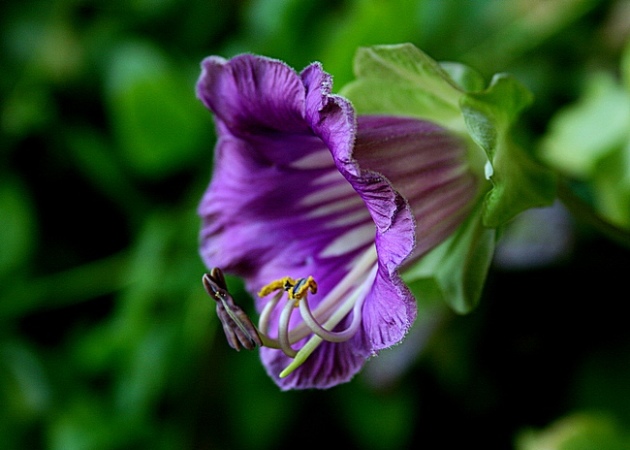
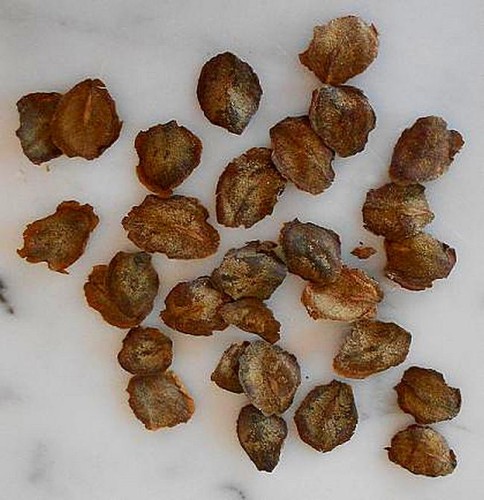

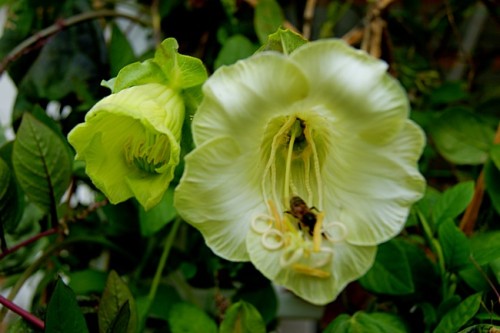
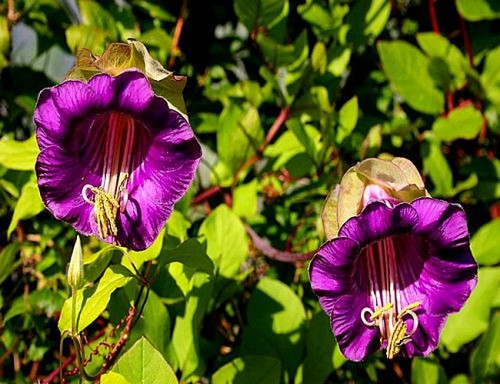
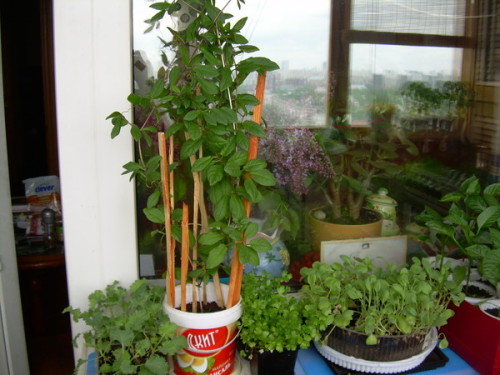
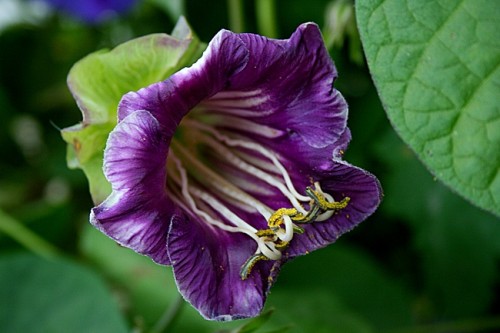

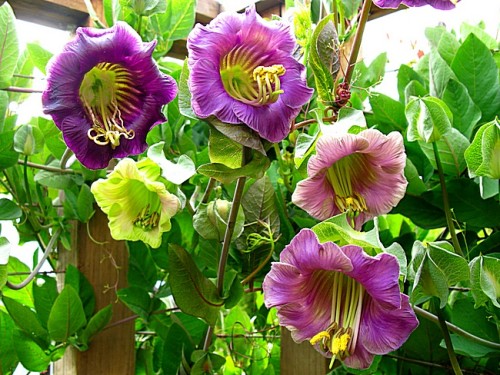
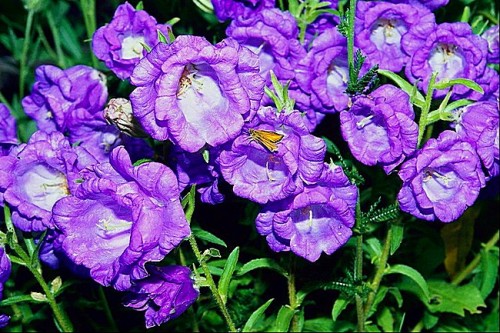
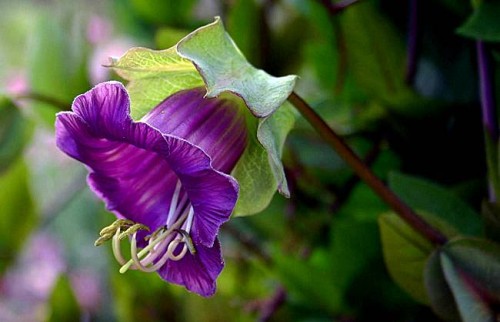
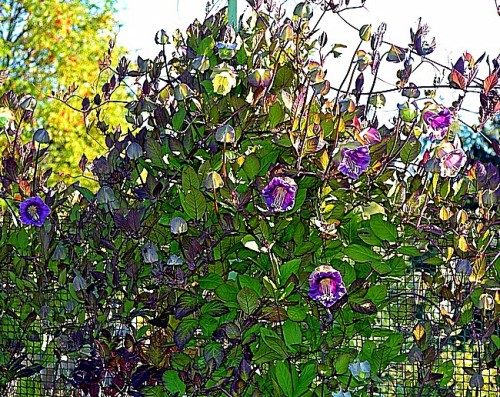
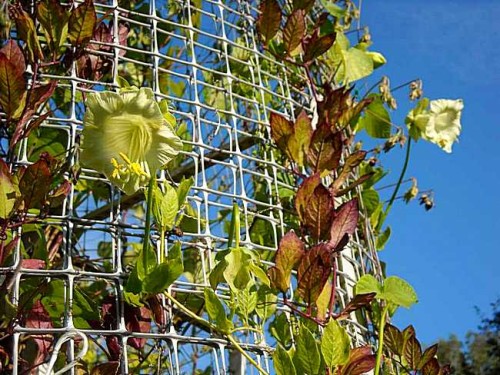
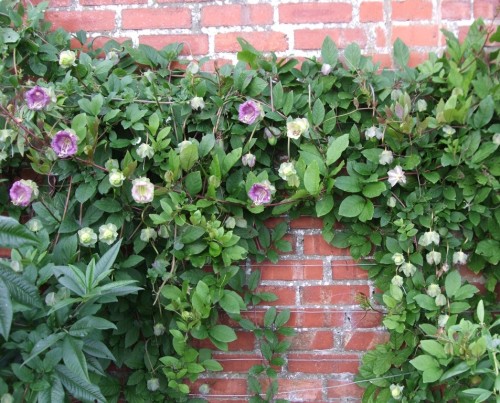





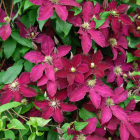
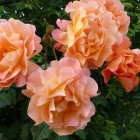

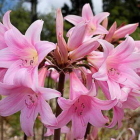
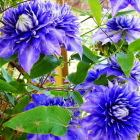
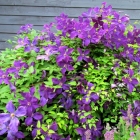
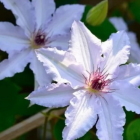
 Start a discussion ...
Start a discussion ...